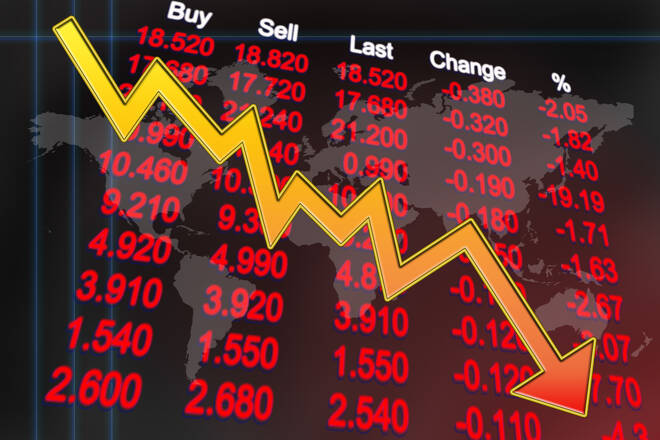Advertisement
Advertisement
Stocks Sink in a Vicious Sea of Red; Oil Bulls Are Blindsided by Stagflation Fear, Rates Down Trigger Demand for JPY, Leaving Gold in No Man’s Land
By:
US equities fell sharply Wednesday, S&P down 4%, the most significant daily decline since June 2020.
Global Macro and Stock Markets Analysis
US equities fell sharply Wednesday, S&P down 4%, the most significant daily decline since June 2020. The weakness came as Target’s quarterly earnings added fuel to the recession risk narrative, while the drop of US10 year yields down 10bps to 2.88% offered little support. And Oil settled at 2.3% lower on the day.
Equities continue to be at the mercy of broader macro themes, with more hawkish comments from Fed Chair Jay Powell leading to a further move higher in front-end rates, which continues to prove problematic for risk.
Medium-term, the Fed is likely to respond to any easing in financial conditions by ratcheting up the hawkish noises and, in effect, acting as a lid on the markets. And this should keep active money on the sidelines.
The relief rally trap door sprung when the S& P 500 4000 pins snapped after Target‘s earnings results exacerbated some recession fears that continued the theme of rising inventories detailed by Walmart on Tuesday. And the broad-based sell-off absolutely hammered tech.
Indeed, contagion from bellwether consumer earnings prints is sending stagflationary shockwaves through the market, and equities suffered another massive bout of indigestion after yesterday’s Alka Seltzer moment.
While rising inventories and higher inventory/sales ratios are not new, the big boxes now confirm recessionary worries and catalyze the severity of the sum of all stagflationary fears.
Oil Fundamental Analysis
The China reopening trade got blindsided by intense global recessionary impulses.
It is a very volatile market, but there are enough reasons to suggest why traders are looking to sell in the current environment.
An actual recession is likely one of the few antagonists that can contain oil prices with a supply deficit. And as the procession to recession shortens, oil prices could continue to fall due to demand concerns.
In addition to Venezuela barrels possibly coming to market offsetting the ongoing political fractious Libyan supply disruption, the EU sanctions package currently under discussion would likely legalize Russian supplies’ status quo at least through the year and take pressure off the prompt contract.
FOREX Fundamental Analysis
It was another busy day in G-10 FX with broad-based dollar demand across the spectrum, driven by a hawkish FED and safe-haven demand, which are two primary supportive channels for King Dollar.
Investors continue to evaluate the diverging approaches taken by central banks amid an inflation crisis. Federal Reserve Chair Jay Powell issued some hawkish comments on Tuesday about the possibility of raising the Fed Funds above neutral. At the same time, the Bank of England seems to have fallen behind the curve with its dovish approach, despite rampant inflation data emerging earlier Tuesday.
But folks that trade for a living, not analyze currencies as a job, are looking to buy JPY, which suggests the worm is turning on USDJPY.
Japanyese Yen
Local investor interest in buying USDJPY in the Asian session saw the pair touch a high in the 129.50/60 zone, coinciding with highs in various JPY crosses.
Since then, the pair has been heavy on rallies and opened the North America session near 129.00/10. This morning we open the Asia session at 128.30 as safe-haven demand is kicking in.
The JPY looks attractive with the global economy on the precipice of recession. JPY is interesting as the rise in USDJPY YTD has opened an enormous value gap for what is typically perceived as a safe-haven currency. Historically FX hedges for massive risk-off scenarios suggest that the YEN provides an excellent firebreak to the recessionary flames, especially against a “stock down rates down” seismic shock or a market backdrop consistent with recessionary pricing.
British Pound
Besides the Brexit risk and the BoE as a reluctant rate hiker, domestic political risk never seems to leave the GBP spectrum. “Red Wall” Conservative members of parliament are planning to ask Chancellor Rishi Sunak to remove Andrew Bailey as governor of the Bank of England. It seems nigh on impossible this would succeed, but it reflects the political pressure being heaped on the BoE.
Bailey is just two years into an eight-year term. Bailey has not helped himself, with comments such as predicting an “apocalyptic” rise in food prices earning him opprobrium from all corners.
Questioning the ability of your top central banker cannot be suitable for the currency.
Swiss Franc
USDCHF and CHF crosses continue to trade heavily, with little bounces, after SNB Chairman Jordan said the central bank is “ready to act if inflation strengthens.”
There is no relief in the crosses after disappointing quarterly results from major retailers weighed on the broader markets.
Gold Fundamentals
Gold is caught in the tug of war between recessionary safe-haven demand and do not fight the fed mode.
It is a tough market for gold investors, with stocks tanking and the street moving into a capitulatory sell-all frame of mind. And even lower bond yields are offering little support leaving bullion investors adrift in no man’s land.
For a look at all of today’s economic events, check out our economic calendar.
About the Author
Stephen Innescontributor
With more than 25 years of experience, Stephen Innes has a deep-seated knowledge of G10 and Asian currency markets as well as precious metal and oil markets.
Advertisement
